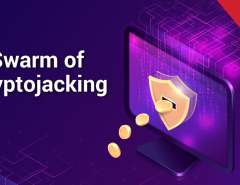Cryptojacking is the dangerous new threat that threatens to cause more headaches to corporate and network administrators the world over. In a way, this was a threat that was coming – the widespread popularity of cryptocurrency was a marker that criminals would try and find a way to garner it using malicious means. And hence, cryptojacking – the perfect solution where the target’s system can be used, or to be correct, hijacked, to do someone else’s dirty work.
So how does it work? Hackers send unsuspecting targets emails with malicious code in them. Or they embed this code into sketchy websites on which targets can click. The hacker succeeds if he/she gets the required click because this malicious code is installed on the target computer.
Now this malicious code works in the background, silently mining cryptocurrency. This takes up a lot of computer resources so this can often mean the computer runs extremely slowly, crashes often and does not work to its earlier capacity, frustrating the users. Sometimes they may not even be aware of the issue why their systems aren’t working like it used to do. It’s easy to conclude then, that cryptojacking is a sneaky but extremely effective way for hackers to get their desired results in exactly the surreptitious, stealthy way they desire.
Read more: Cryptocurrency: The Good, The Bad & The Ugly
But there are means and ways to stop this dangerous threat and it is critical that corporate wake up to cryptojacking’s dangers. If corporates do not want to deal with continuous server outages and high electricity consumption bills, they must ensure that cryptocurrency is identified right at the beginning through the following methods:
Recognize the signs: Typical cybersecurity software may not be able to detect cryptojacking as it is still a new and rapidly changing problem. So ensure that your company can detect the other symptoms that arise from a successful cyrptojacking attempt. Slow computer performance, overheating systems, CPU fan failures, excessive heat could all be symptoms of a successful cryptojacking operation.
Monitor the network: It is important for corporate to have a proper network monitoring solution as this can be very useful in detecting cryptojacking attempts. By reviewing web traffic, network administrators can look for anomalies. Sometimes, activity from individual users can provide the clue to heightened processing which might mean cryptojacking. A lot of network monitoring software nowadays use artificial intelligence solutions to analyze network data.
Keep your own website safe & secure: Attackers can try and manipulate web servers to embed cryptojacking into official websites of corporates. This could mean that users who access the website will get affected, leading to a major loss of reputation for the company. It is important for a business to be aware of even the smallest changes on the web server or changes to the website itself.
Stay aware: Like every cybersecurity threat around, cryptojacking is also evolving. It is currently in a nascent stage and will only get more clever and dangerous in its aim to mine cryptocurrency. After all, the criminals need only one successful attempt. Business owners and network administrators must be aware of the latest trends and changes in the attack mechanism so they can take the correct decisions without delaying.
In the event that the damage is already done, here are some steps to recover and fight a crypojacking attack:
- The Web Filtering of your relevant security solution should be used to immediately block and blacklist the offending website from where the cryptojacking malware is being downloaded.
- Block browser extensions for a while as the company tries to understand the attack and the scale of the damage it has caused.
- Take the necessary learning from the attack and put measures in place so that this is not repeated again. Organize debriefing sessions for stakeholders so that everyone is aware of what happened, the measures taken and what is being done to prevent such a thing again.
To protect your organization from cryptojacking attacks, it is important to have a network security solution in place. Seqrite’s Unified Threat Management solution offers ease of use and brings key security features such as network security, management, backup and recovery of data and other critical network services together under a single unified umbrella.
For mobile devices, businesses should consider investing in a mobile device management solution which will allow employees to have the privilege of mobile productivity without compromising the security of the corporate network. Seqrite’s Mobile Device Management (MDM) is a comprehensive solution which offers all basic and advanced features enabling companies to defend themselves from cryptojacking malware or malicious attacks.
As an IT security partner for your business, Seqrite provides comprehensive security from advanced cyber threats. To know more



